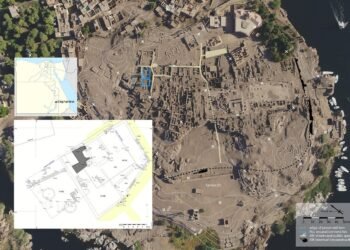The mysterious inscription on a bronze sphinx statue, unearthed in the early 19th century in the Roman province of Dacia (modern-day Romania), has finally been deciphered after more than a century of scholarly puzzlement. The statue, dating back to the 3rd century, was discovered during archaeological excavations in the ancient Roman settlement of Potaissa.

This enigmatic artifact, believed to have originated from the Greek island of Naxos, features a unique blend of Greek and Roman artistic traditions, carved in the elegant Naxian style but found far from its place of origin.
The sphinx, symbolizing wisdom and typically depicted with a lion’s body and a human head, was placed during the Roman domination of Dacia, suggesting a role in guarding important structures like forums, temples, or administrative buildings.
The inscription, engraved on the base of the sphinx, remained a mystery for over a century due to its unconventional characteristics. Notably, it reads from left to right, contrary to ancient norms, and employs the archaic Greek alphabet.


Researchers, led by Peter Revesz, a professor at the University of Nebraska, finally cracked the code, revealing a short but “unusual” poem in Proto-Hungarian, a language not commonly associated with ancient Roman artifacts.
According to Revesz, the translated poem reads, “Lo, behold, worship: here is the holy lion,” indicating a devotional purpose associated with the sphinx. This discovery is of particular significance because, as Revesz emphasizes, “the sphinx cult was not part of the mainstream ancient Roman mythology.”
The sphinx, believed to have guarded an important area in Potaissa, was stolen or lost in 1848 from the collection of Count Kemény and has never been recovered. Despite its disappearance, detailed drawings of the sphinx have preserved the inscription and aided researchers in their decoding efforts.
The study, published in the journal Mediterranean Archaeology and Archaeometry on December 30, highlights the meticulous process undertaken by the research team to decipher the degraded inscription. The text, written in dactylic hexameter, a poetic meter originating from ancient Greek verses, was transcribed and translated to reveal its significance in the context of a religious ceremony. The sphinx worship ceremony likely involved inserting the spike beneath the statue’s pedestal into a raised ring while uttering the inscribed phrases, creating a ritualistic experience for worshipers.
The inscription’s unconventional characteristics, including its linguistic paradox and departure from traditional reading norms, had confounded scholars for decades. Peter Revesz, the lead researcher on the study, underscores the uniqueness of the sphinx statue in documenting a minority religion within the Roman Empire, where evidence is often scarce.





















